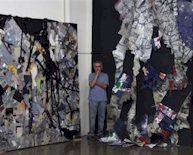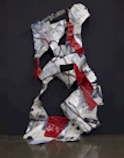ARTIST NAME: Bridget Riley
|
 |
|
Bridget Riley:
Bridget Riley was born in 1931 at Norwood, London, the daughter of a businessman. Her childhood was spent in Cornwall and Lincolnshire. She studied at Goldsmiths College from 1949 to 1952, and at the Royal College of Art from 1952 to 1955. Riley has exhibited widely since her first solo show in 1962. Among numerous exhibitions, she was included in the 1968 Venice Biennial where she won the International Prize for painting. Riley began painting figure subjects in a
semi-impressionist manner, then changed to the Neo-Impressionist
technique of Pointillism around 1958, mainly producing landscapes. The
same year she was deeply impressed by the large Jackson Pollock
exhibition at the Whitechapel Art Gallery in London. After a major retrospective in the early Seventies, Riley began to travel extensively. Up until early 1980 she had been working on her 'curve' paintings, but these came to an end after a particularly inspiring sojourn in Egypt. Her extensive exploration of color and contrast began after this. In 1983 she designed a mural made up of soothing bands of blue, pink, white and yellow for the Royal Liverpool Hospital. In the same year, she made her first set for the ballet 'Color Moves' first performed at the Edinburgh Festival in 1983. Three years later she met the postmodern 'Simulationist' painters Philip Taaffe and Ross Bleckner, and was inspired to introduce a diagonal element to her work, thus adding another dimension to her fascination with the juxtaposition of colors. Bridget Riley is one of Britain's best-known artists. Since the mid-1960s she has been celebrated for her distinctive, optically vibrant paintings which actively engage the viewer's sensations and perceptions, producing visual experiences that are complex and challenging, subtle and arresting. Riley is acclaimed as one of the finest exponents of Op Art, with her subtle variations in size, shape and position of blocks within the overall pattern. Her work is characterized by its intensity and it's often disorientating effect. Indeed the term 'Riley sensation' was coined to describe this effect of looking at the paintings, especially her early black and white pictures. Riley is fascinated with the act of looking and in her work aims to engage the viewer not only with the object of their gaze but also with the actual process of observation. "For me Nature is not landscape, but the dynamism of visual forces - an event rather than an appearance - these forces can only be tackled by treating color and form as ultimate identities, freeing them from all descriptive or functional roles." Bridget Riley. Though her work is abstract, the optical experiences obtained through viewing her work seem surprisingly familiar. During her childhood, when she lived in Cornwall, she formed an acute responsiveness to natural phenomena. In particular, the effects of light and color in the landscape. Though her mature work does not proceed from observation, it is nevertheless connected with the experience of nature. Of her paintings, she has commented: 'the eye can travel over the surface in a way parallel to the way it moves over nature. It should feel caressed and soothed, experience frictions and ruptures, glide and drift…One moment there will be nothing to look at and the next second the canvas seems to refill, to be crowded with visual events.' This parallel relation between Riley's art and nature has underpinned the development of her work, coloring the way it forms both an exploration and a celebration of a fundamental human experience: sight. |
Bridget Riley Books





 Find
out how much an artwork of Bridget Riley is worth
Find
out how much an artwork of Bridget Riley is worth

